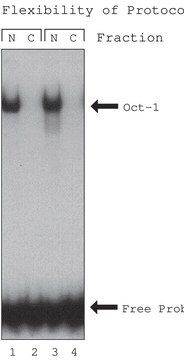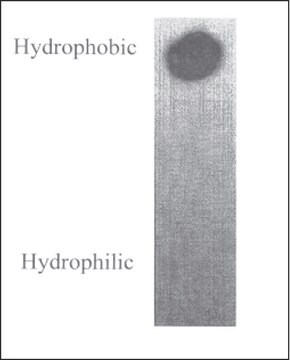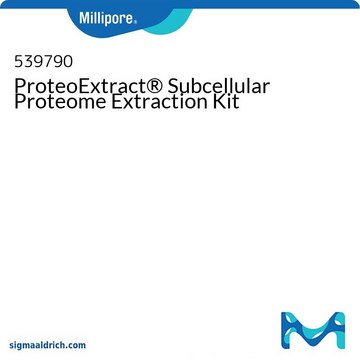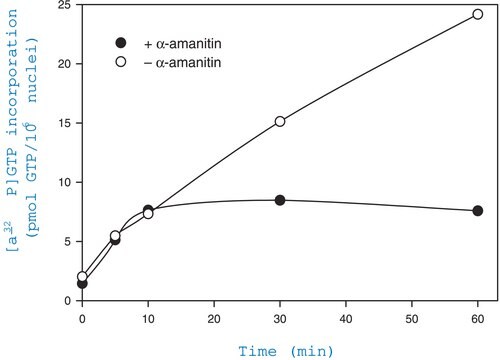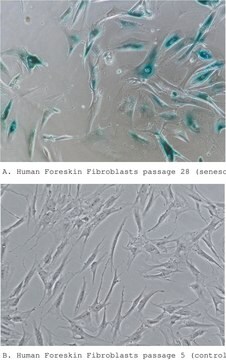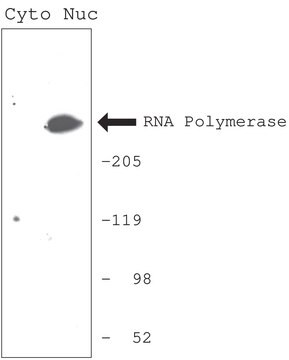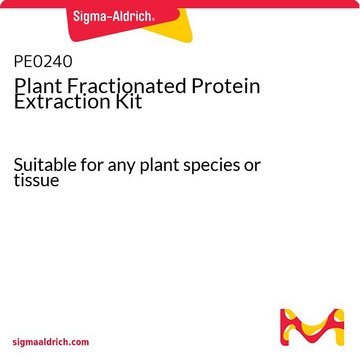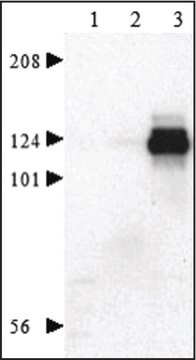Wszystkie zdjęcia(1)
Kluczowe dokumenty
PROTMEM
ProteoPrep® Membrane Extraction Kit
Zaloguj sięWyświetlanie cen organizacyjnych i kontraktowych
About This Item
Kod UNSPSC:
12352200
NACRES:
NA.32
Polecane produkty
temp. przechowywania
2-8°C
Opis ogólny
ProteoPrep® Membrane Extraction Kit reagents utilize a powerful detergents for higher loading and resolution of proteins in 2D gels. Protein Extraction Reagent Types 3 and 4 are optimized for proteomic studies. Extraction reagents 3 and 4 are ideal for protein extraction prior to isoelectric focusing and 2D electrophoresis. This kit also includes reagents for the reduction and alkylation of disulfide bonds. The ProteoPrep® Membrane Extraction Kit was designed through a collaboration of Proteome Systems and Sigma research scientists.
Zastosowanie
ProteoPrep® Membrane Extraction Kit is designed to prepare highly enriched membrane protein solutions from many types of cells. The final protein solution are suitable for 2D gel electrophoresis.
Cechy i korzyści
- Innovative detergent preparations - Improved solubility allows for higher protein loads and greater visibility of low abundance proteins in 2D gels.
- Two pre-mixed solubilization solutions - Removes interfereing non-membrane proteins prior to extractions, resulting in uncluttered 2D arrays.
- Pre-measured reducing & alkylating reagents - Easy-to-use reagents provide improved IEF resolution.
Informacje prawne
ProteoPrep is a registered trademark of Merck KGaA, Darmstadt, Germany
Ta strona może zawierać tekst przetłumaczony maszynowo.
Elementy zestawu są też dostępne oddzielnie
Numer produktu
Opis
Karta charakterystyki
Hasło ostrzegawcze
Danger
Zwroty wskazujące rodzaj zagrożenia
Zwroty wskazujące środki ostrożności
Klasyfikacja zagrożeń
Acute Tox. 3 Oral - Aquatic Chronic 2 - Carc. 2 - Eye Dam. 1 - Repr. 1B - Resp. Sens. 1 - Skin Corr. 1A - Skin Sens. 1 - STOT SE 3
Organy docelowe
Respiratory system
Kod klasy składowania
6.1C - Combustible acute toxic Cat.3 / toxic compounds or compounds which causing chronic effects
Temperatura zapłonu (°F)
186.8 °F - closed cup
Temperatura zapłonu (°C)
86 °C - closed cup
Wybierz jedną z najnowszych wersji:
Masz już ten produkt?
Dokumenty związane z niedawno zakupionymi produktami zostały zamieszczone w Bibliotece dokumentów.
Klienci oglądali również te produkty
Lili Xu et al.
The Journal of general virology, 90(Pt 11), 2695-2703 (2009-07-25)
Raccoon dog is one of the suspected intermediate hosts of severe acute respiratory syndrome coronavirus (SARS-CoV). In this study, the angiotensin-converting enzyme 2 (ACE2) gene of raccoon dog (rdACE2) was cloned and sequenced. The amino acid sequence of rdACE2 has
Sreepriya Nair et al.
Electrophoresis, 32(24), 3621-3629 (2011-11-22)
Performing 2-DE of lipid-rich multilamellar membranes like myelin is a cumbersome task. However, for understanding its molecular organization and changes during diseases, identification of proteins of myelin is essential. Although the 2-D-proteomic approach of myelin has been employed to understand
Fang Chen et al.
Proteomics, 7(9), 1529-1539 (2007-04-05)
Plant plasma membrane (PM) proteins play important roles in signal transduction during defense response to an attacking pathogen. By using an improved method of PM protein preparation and PM-bound green fluorescent protein fusion protein as a visible marker, we conducted
Carla Cacciotto et al.
BMC microbiology, 10, 225-225 (2010-08-27)
Mycoplasmas are the simplest bacteria capable of autonomous replication. Their evolution proceeded from gram-positive bacteria, with the loss of many biosynthetic pathways and of the cell wall. In this work, the liposoluble protein complement of Mycoplasma agalactiae, a minimal bacterial
Haiqing Sheng et al.
Applied and environmental microbiology, 74(16), 5015-5022 (2008-06-17)
Escherichia coli O157:H7 causes hemorrhagic colitis and the life-threatening hemolytic-uremic syndrome in humans and transiently colonizes healthy cattle at the terminal rectal mucosa. To investigate the role of the O antigen in persistence and colonization in the animal host, we
Nasz zespół naukowców ma doświadczenie we wszystkich obszarach badań, w tym w naukach przyrodniczych, materiałoznawstwie, syntezie chemicznej, chromatografii, analityce i wielu innych dziedzinach.
Skontaktuj się z zespołem ds. pomocy technicznej


